If you’re like most homeowners, you probably don’t know much about your roof. This is understandable because you shouldn’t have to think about it until there’s a problem or it’s time for a replacement.
But when the time does come for a new roof, there’s a lot you’ll have to learn. The best way to start is by learning about what actually makes a roof a roof.
For over 30 years, the team at Bill Ragan Roofing has educated homeowners on every aspect of a roof replacement. Because of this, I’ll be breaking down the components that make up your roof system.
Let’s get to the main 8 components of a residential roof system and their purpose.
1. Roof decking
Roof decking (also called roof sheathing) is the wooden boards (plywood or planks) that make up the foundation of your roof system. Decking is the groundwork of your entire roof system that the rest of your roof is installed on.
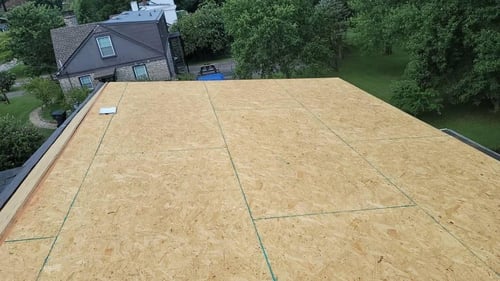 (OSB roof decking)
(OSB roof decking)
There are two types of roof decking: plank decking and sheet decking. Plank decking is made up of elongated and rectangular wooden boards that come in 2 different sizes, 1x6 or 1x8.
Sheet decking (or sheathing) is literally flat sheets of wood, either plywood or OSB.
OSB (oriented strand board) is made up of wood chips/strips compressed together to form a flat 7/16” sheet. Plywood comes in several different thicknesses (⅜”, ½”, ⅝”, and ¾”) depending on the span of the rafters.
If your roof’s decking is rotten or can’t handle the installation of a new roof, it’ll need to be replaced. But unfortunately, your roofing contractor won’t know if or how much will need replacing until your old roof is torn off during your roof replacement.
2. Drip edge
Drip edge is metal flashing installed at the roof’s edges (eaves and rakes) to keep water from getting underneath your roofing components. Without it, your fascia board and roof decking will rot from extended exposure to water.
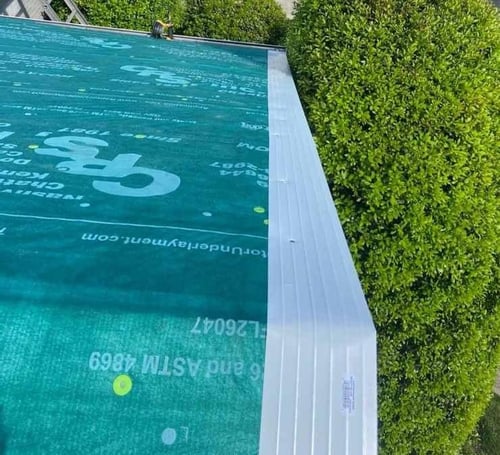
Installing drip edge at the rakes and eaves is actually a required building code. Not only does your home need it to pass an inspection, but it must be installed correctly as well.
Unfortunately, we see too many roofs without drip edge because some roofing contractors leave it off to keep their prices lower or from pure laziness. If your roof estimate doesn’t have a line item for drip edge, you need to bring it up or find another roofer altogether.
3. Roof underlayment
Roof underlayment is a material installed between your roof decking and your roofing material (asphalt shingles, metal roof, etc.) to provide an extra layer of protection from the elements. If water does get underneath your roofing materials, underlayment is there to protect your roof decking.
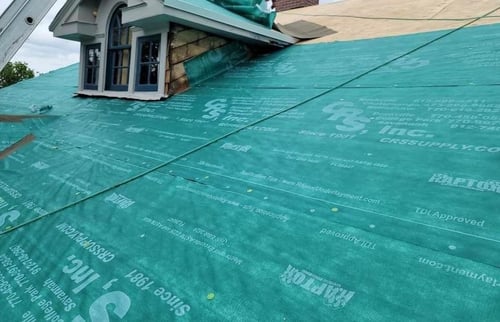 (Synthetic underlayment)
(Synthetic underlayment)
There are two different types of underlayment: felt and synthetic.
Felt underlayment has been around the roofing industry longer and comes in 15 lb and 30 lb rolls. While both types do the job, 30 lb felt underlayment is thicker, stronger, and less likely to tear than 15 lb.
Synthetic underlayment is made out of woven/spun polyethylene or polypropylene. Synthetic underlayment is more durable, holds nails better, and repels water better than felt underlayment.
While felt isn’t a bad choice, I recommend spending the money for the extra protection and functionality synthetic underlayment offers.
4. Ice and water shield
Ice and water shield is a waterproof membrane that protects your roof from ice and water damage. Just like underlayment, its main purpose is to protect your roof decking from water getting under your roofing material.
.jpg?width=500&name=IceandWaterShieldUpgrade%20(2).jpg)
But unlike underlayment, ice and water shield is installed on/around certain potential problem areas that need a little more protection. These areas include roof valleys, around penetrations, and roofs that have a 2/12, 3/12, or 4/12 pitch.
If you live above the snow line in the US, there’s also a building code for this component. The code requires installing ice and water shield along the edges of your roof to prevent leaking from ice damming from snow or ice.
This means you’ll have 2 rows of ice and water shield along your roof’s rakes and eaves to ensure your roof is up to code. This is considered an "upgrade" for areas like Middle Tennessee to prevent ice damming leaks when we get heavy snowfall.
5. Roof flashing
Roof flashing is a metal material that directs water away from certain areas (walls, chimneys, roof valleys) of your roof. Even though all the components in this article are important, roof flashing is probably one of the most important.
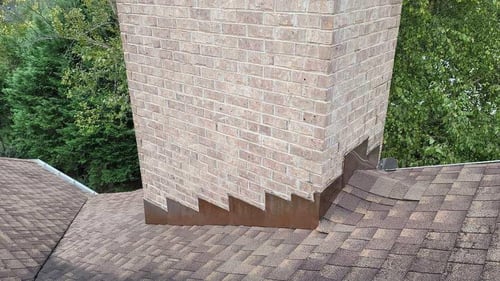 (Flashing around chimney)
(Flashing around chimney)
Without it, you’ll definitely have roof leaks. You’ll have different metal options for roof flashing. The most common types of metals used are aluminum, steel, and copper.
Steel is the most popular choice for residential roof systems today and it gives your roof a clean look that fits most budgets. But if you want an upgraded look, copper looks great aesthetically but will cost more upfront.
No matter which metal you choose, it should outlive the other roofing components. However, I always recommend replacing your roof flashing when it’s time for a new roof.
This is simply to prevent future problems and ensure all of your components are the same age.
6. The roofing material you choose
The biggest part of your residential roof system is the roofing material you choose. The 5 most popular types of residential roofing materials are asphalt shingles, standing seam metal roofing, cedar shake roofing, synthetic roofing, or slate roofing.
Unfortunately, I can’t go into each one of the roofing materials in this article. It’s just important to know the roofing material has a huge impact on the cost, aesthetic, lifespan, and warranty options of a new roof.
So, it’s important to pick the right one for you. If you hang around until the very end, you’ll get something to help you choose the right one.
7. Ridge capping
Ridge capping is installed where two slopes of a roof meet at the very top. No matter what roofing material you have, your roof needs ridge capping to ensure it’s sealed at the top.
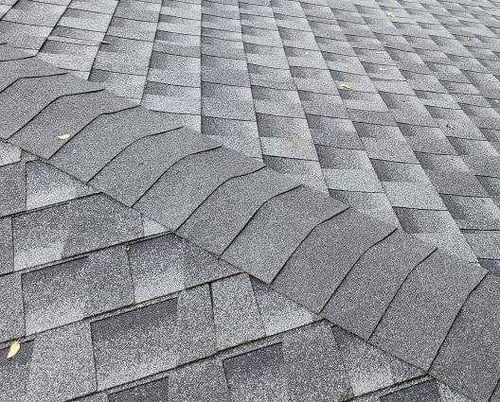
Ridge capping comes pre-bent, so it can perfectly form to a roof’s ridge. Unfortunately, some roofing contractors try to avoid using ridge capping to keep their costs low on an asphalt roof replacement.
They do this by installing 3-tab shingles at the ridge instead of a manufacturer's ridge capping. They’re not meant to be used this way and will lead to a roof leak.
8. Roof vents
Roof vents allow your attic and home to breathe properly. The two ventilation systems (active and passive) have different roof vents options to choose from.
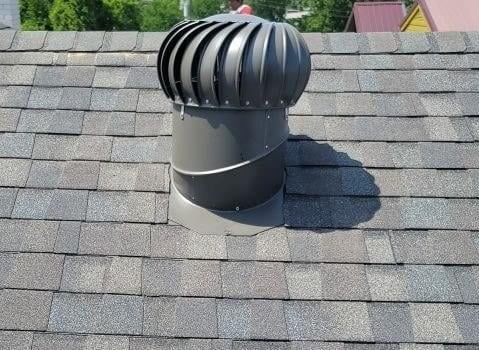 (Turbine vent)
(Turbine vent)
If you have an active ventilation system, you’ll choose turbine vents, power vents, ridge vents with a baffle, or solar-powered vents.
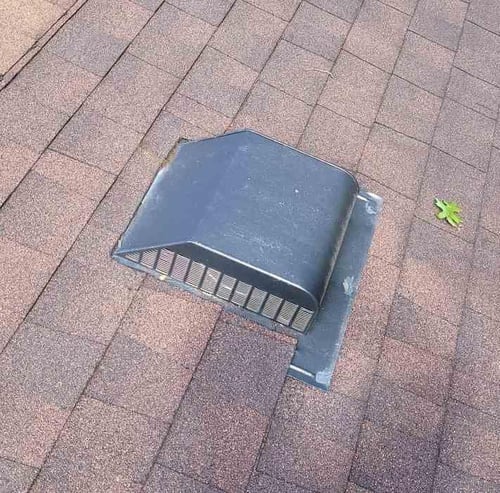 (Box vent)
(Box vent)
For a passive ventilation system, you choose from static vents (box vents), ridge vents without a baffle, or gable-end vents. I recommend an active ventilation system for performance reasons.
No matter which one you have, your roof’s life will be cut drastically short if your attic isn't vented properly. Your energy bills will also be higher if your home can’t breathe because your attic isn’t well ventilated.
Get the guide with all the information you need for a residential roof replacement
Now you know the 8 main components of a residential roof system. After reading this article, you now know the basics of what makes a roof a roof.
But there’s even more to learn about your roof and a roof replacement in general. And remember, you have to choose the right roofing material.
To do this, we created a buyer’s guide with all the information needed to choose the right roofing material and to learn more about your upcoming roof replacement.
It also gives you key information about finding a great roofing contractor, the cost of a roof, and so much more. With this guide, you can count on being the most informed homeowner in the industry and will have all the knowledge you need for a roof replacement.
Since 1990, the team at Bill Ragan Roofing has provided high-quality roofing services to thousands of homeowners in Nashville and surrounding Middle Tennessee areas. No matter what you need, you’ll never have to worry about your roof again when working with us.
Here’s The Complete Guide to Purchasing a Roof to continue learning everything you need to know about your upcoming roof replacement.



